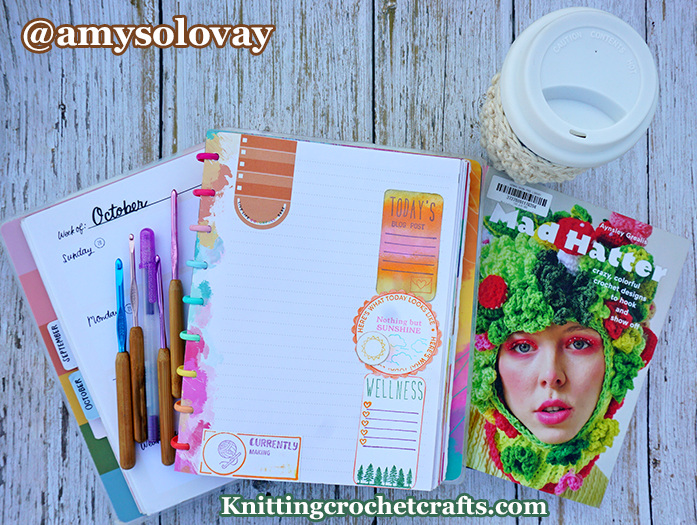
This is a book review of Mad Hatter: Crazy, Colorful Crochet Designs to Hook and Show Off.
TL;DR Summary: I highly recommend this book! I think it is an outstanding value for the money, and the projects in this book are 100% worth the time, yarn and money you’ll need to spend to make them.
——–
My Full Review of The Mad Hatter Book by Aynsley Grealis
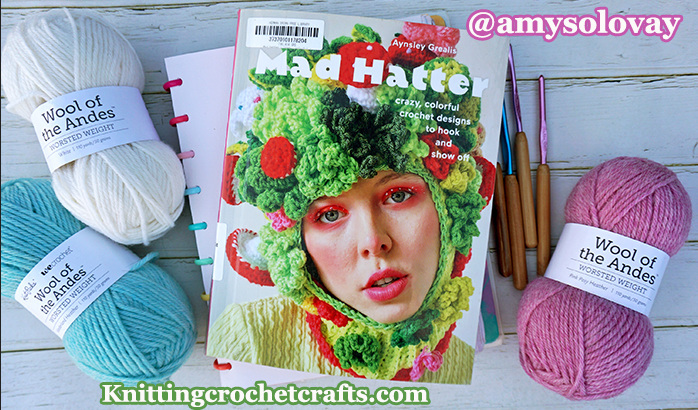
Do you ever have a need for crocheted flower, mushroom, rainbow or fish embellishments?
How about patterns for crocheting simple accessories that cfloweran be embellished (or not), as you prefer? Do you have a need for those?
Would you be interested in making uniquely embellished crochet projects like hats and bags that show off your personal style aesthetic?
Do you find it enjoyable to mix, match and style different elements to create an entirely new and different look for yourself or your friends?
If you answered “yes” to any of the questions above, I think you’re going to enjoy Aynsley Grealis’ brand new book called Mad Hatter: Crazy, Colorful Crochet Designs to Hook and Show Off.
What You Need to Know About This Crochet Pattern Book:
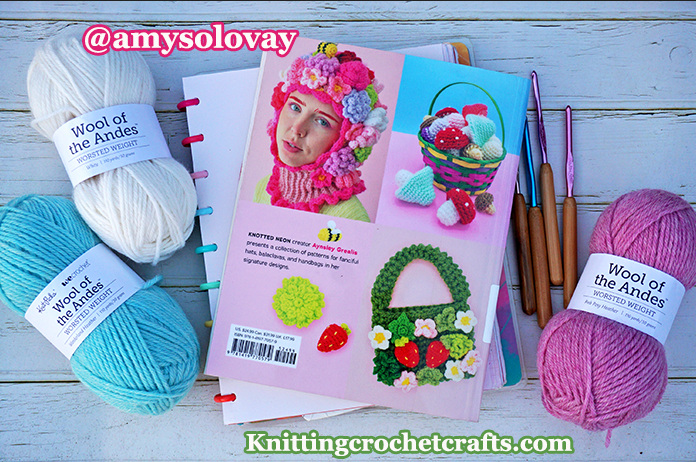
Author: Aynsley Grealis
Publisher: Harry N. Abrams
Copyright Date: 2024
ISBN 13: 978-1419770579
ISBN 10: 1419770578
Book Formats:
This book is available in the following format(s):
Number of Pages: 144
Crochet Skill Level: These patterns are unrated, but if you were to ask me to rate them, I’d assign them a crochet skill level rating of “easy.” The crocheting is easy; and the finishing on some of the projects is easy, while the finishing on some of the others is fairly complex. But if you can thread a needle with yarn and then use it to stitch through multiple layers of crocheted fabric, you can figure this out. I encourage you to give it a try!
What Mad Hatter Is All About:
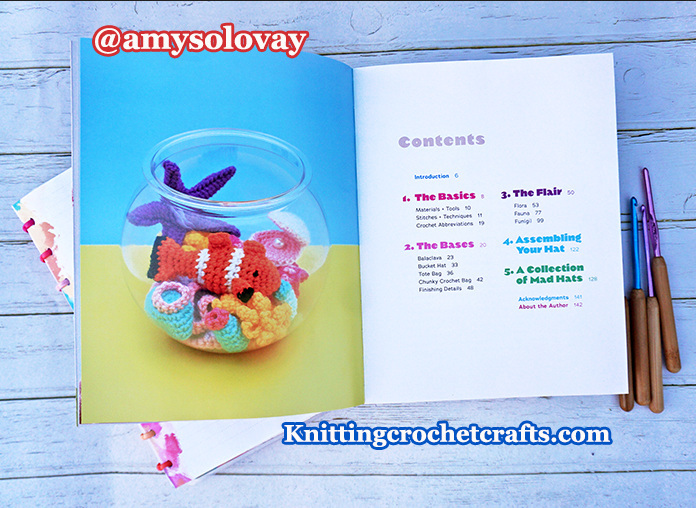
This book offers you a collection of mix-and-matchable crochet patterns:
You can start with any of the 4 simple base patterns that the book’s author, Aynsley Grealis has designed:
- a balaclava
- a bucket hat
- A tote bag
- A chunky handbag
Then you can embellish any of these base projects using what Grealis calls “The Flair.”
“The Flair” = another way of saying “appliques and embellishments.” These are all items that you can stitch onto the base projects to dress them up and make them more eye-catching.
The “flair” items presented in this book aren’t all flat like typical appliques are; many of them are three-dimensional. This is part of what makes Grealis’ finished creations look so creative and eye-catching; their three-dimensionality is a large part of their appeal.
But, if you’re one who looks at these projects and thinks, “I could never wear that,” don’t worry! You could dial down the effects quite a bit, and make the projects less daring, simply by changing out the “flair” you use from three-dimensional objects to flatter ones.
”Flair” Patterns Included in This Book: Flowers, Roses, Clouds, Rainbows, Bees, Mushrooms, Plants and More
You can use the flair patterns for crocheting replicas of recognizable items like plants, flowers, mushrooms, bees and strawberries.
My Experiences With Mad Hatter:Crochet Projects I Made From the Patterns in This Book
So far, I have only crocheted one pattern from this book: I made this small crocheted rose:
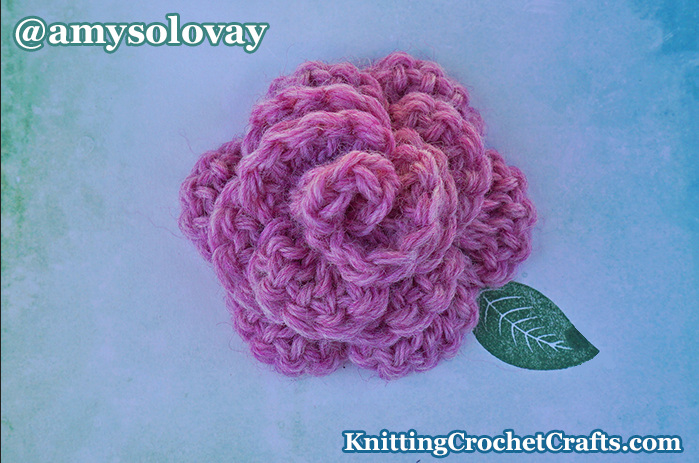
I think it turned out fantastic! Would you agree?
I crocheted the rose using Wool of the Andes worsted weight yarn in the “Pink Posy Heather” colorway.
I found the small crochet rose pattern to be clearly written, well presented and easy to follow. I am super pleased with the results!
I have plans to crochet more projects from this book, and I will update the review again in the future if I have anything additional to add to the discussion.
The Best Things About This Book
The thing I personally find most appealing about this book: It is essentially a library of very simple patterns for making extremely useful items like bags, hats, appliques and shapes.
This book offers you one of the best collections of simple, pretty, appealing crochet flower applique patterns that I am currently aware of.
The flowers are the items that are going to be most useful to me, personally, but the other items (mushrooms, plants, stars, hearts, fish, plants, coral, a rainbow, a strawberry, etc) are likely to also come in handy.
The book is beginner-friendly because it offers you abundant work-in-progress photos. These are helpful no matter what your level of experience with crochet is, but if you’re new to crocheting, you’ll no doubt find them especially valuable.
The styling in this book is delightful. The projects are presented in a creative and compelling way, but the styling is also simple enough that it doesn’t detract from the projects.
Furthermore, this book offers you a unique and fascinating jolt of inspiration for adding artistry to your wardrobe and your life. But you can get inspired by this book without needing to create these projects exactly as they are presented.
I’m not personally going to wear a bright-colored balaclava that’s decorated with flowers, rainbows, mushrooms or fish. That’s not my personal style at all.
BUT! This book is 100% usable to me despite that, because each simple pattern in this book is one I can use in other ways.
This is because I am not obligated to style my own finished projects in the exact same way that Grealis has styled them.
And neither are you obligated to style your own finished projects that way.
You can if you want to! But you don’t have to.
So if you love and adore Grealis’ fun, playful, colorful, over-the-top maximalist style, you can emulate it exactly using the patterns in this book.
But even if you look at these designs and think, “I wouldn’t have the nerve to wear that,” this book might still be exactly what you want – because you get total control over how much embellishing you want to do to each individual piece you create.
For example, you could create minimalistic hats and / or bags using the base patterns in this book without any embellishment at all. Or you could choose to embellish each of these projects with ONE simple flower, rather than completely covering the hat or bag with flowers.
The projects in this book are amazingly versatile; you can do as much or as little embellishing as you like.
Each finished piece is made up of multiple elements that are each relatively
basic.
To arrive at the finished projects like the colorful multicolored balaclava pictured on the book’s front cover, you combine the base pattern with a bunch of colorful, three-dimensional “flair” pieces.
When you put them all together, the way Grealis does, the effect is over-the-top and spectacularly cool.
But the coolest thing about this is that Grealis, gives you a pattern for creating each individual element that goes into these head-turning creations – and each element, on its own, is rather easy and doable.
The basic patterns are extremely simple, pared-down designs.
So you could crochet any of these items and use them on their own, without adding any additional embellishments to them.
Furthermore, you don’t need to add any of Grealis’ embellishments to them; if you already have some crochet applique patterns in your pattern stash, you can use pretty much any applique pattern to create embellishments that you can stitch to these projects.
And you don’t even have to make your own embellishments; it is also possible to use any other embellishments from anywhere.
(For example, you could use store-bought sew-on patches to attach to these bag bases. Got a favorite sports team? You could stitch one of their embroidered patches onto the bag, along with whatever other elements you want to use.)
(That said, for best results, I recommend using only embellishments that are either removable or washable, so that you can easily wash your project when it inevitably gets dirty.)
The Main Takeaway: If you use this book and the designs in it as a creative springboard, or a starting point for your own customized projects, the end result can be something that’s highly personalized just for you, the creator – or just for the recipient, if you decide to make any of these projects as gifts.
I think this is truly exciting! Don’t you?
But maybe the idea of getting that creative scares you a little, because you haven’t yet developed the confidence to listen to your own inner voice’s creative suggestions.
That’s okay, too. In that case, this book still has a massive amount to offer you. You can play around with making the various elements in this book and combining them in ways that speak to you. Or you can copy Grealis’ designs precisely, if that’s what you want to do.
Step-By-Step Photo Tutorials Included in This Book
This book includes a number of work-in-progress photos. Some of them accompany the crochet patterns, and some of them accompany text instructions for learning basic crochet techniques.
The crochet tutorials included in this book are as follows:
- How to make a magic ring (This tutorial includes photos and written instructions for learning this basic crochet technique.)
- How to crochet a chain stitch (This tutorial includes photos and written instructions for learning this basic crochet stitch.)
- How to do half double crochet stitch (This tutorial includes photos and written instructions for learning this basic crochet stitch.)
- How to do double crochet stitch (This tutorial includes photos and written instructions for learning this basic crochet stitch.)
- How to decrease in single crochet (This tutorial includes written instructions and photos for learning this technique.)
- How to decrease in half double crochet (This tutorial includes written instructions and photos for learning this technique.)
- How to change colors (This tutorial includes written instructions and photos for learning this technique.)
- How to work in rounds (This tutorial includes written instructions and photos for learning this technique.)
- How to fasten off your work(This tutorial includes written instructions and photos for learning this technique.)
- How to crochet a balaclava (this photo tutorial is a supplement to the pattern included in this book, and it shows multiple work-in-progress pics.)
- How to crochet a bucket hat (this photo tutorial is a supplement to the pattern included in the book, and it shows multiple work-in-progress pics.)
- How to crochet a tote bag and attach the straps to the bag (this photo tutorial is a supplement to the pattern included in the book, and it shows multiple work-in-progress pics.)
- How to crochet a chunky handbag (this photo tutorial is a supplement to the pattern included in the book, and it shows multiple work-in-progress pics.)
- How to crochet a 5-petal flower (this photo tutorial is a supplement to the pattern included in the book, and it shows multiple work-in-progress pics.)
- How to crochet a Gerbera daisy (this photo tutorial is a supplement to the pattern included in the book, and it shows multiple work-in-progress pics.)
- How to crochet a large rose (this photo tutorial is a supplement to the pattern included in the book, and it shows multiple work-in-progress pics.)
- How to crochet a small rose (this photo tutorial is a supplement to the pattern included in the book, and it shows multiple work-in-progress pics.)
- How to crochet a sunflower (this photo tutorial is a supplement to the pattern included in the book, and it shows multiple work-in-progress pics.)
- How to crochet a marigold (this photo tutorial is a supplement to the pattern included in the book, and it shows multiple work-in-progress pics.)
- How to crochet a sunflower (this photo tutorial is a supplement to the pattern included in the book, and it shows multiple work-in-progress pics.)
- How to crochet a daffodil flower (this photo tutorial is a supplement to the pattern included in the book, and it shows multiple work-in-progress pics.)
- How to crochet grass (this photo tutorial is a supplement to the pattern included in the book, and it shows multiple work-in-progress pics.)
- How to crochet seaweed (this photo tutorial is a supplement to the pattern included in the book, and it shows multiple work-in-progress pics.)
- How to crochet a small plant (this photo tutorial is a supplement to the pattern included in the book, and it shows multiple work-in-progress pics.)
- How to crochet a pointy succulent (this photo tutorial is a supplement to the pattern included in the book, and it shows multiple work-in-progress pics.)
- How to crochet a bird’s nest fern (this photo tutorial is a supplement to the pattern included in the book, and it shows multiple work-in-progress pics.)
- How to crochet and assemble a large plant (this photo tutorial is a supplement to the pattern included in the book, and it shows multiple work-in-progress pics.)
- How to crochet leafy coral (this photo tutorial is a supplement to the pattern included in the book, and it shows multiple work-in-progress pics.)
- How to crochet bubble coral (this photo tutorial is a supplement to the pattern included in the book, and it shows multiple work-in-progress pics.)
- How to crochet a sea anemone (this photo tutorial is a supplement to the pattern included in the book, and it shows multiple work-in-progress pics.)
- How to finish and put together a crocheted clam (this photo tutorial is a supplement to the pattern included in the book, and it shows multiple work-in-progress pics.)
- How to finish a crocheted clown fish (Hey! Look! You just found Nemo! haha I say this because if there are any kiddos in your inner circle who like that movie, you can crochet this little clown fish pattern and give your resulting project to them as a passable Nemo toy, although this pattern isn’t in any way associated with the actual Finding Nemo movies or licensed products.) (this photo tutorial is a supplement to the pattern included in the book, and it shows multiple work-in-progress pics.)
- How to crochet a starfish (this photo tutorial is a supplement to the pattern included in the book, and it shows multiple work-in-progress pics.)
- How to crochet a bumblebee (this photo tutorial is a supplement to the pattern included in the book, and it shows multiple work-in-progress pics.)
- How to crochet a snail (this photo tutorial is a supplement to the pattern included in the book, and it shows multiple work-in-progress pics.)
- How to finish a crocheted mushroom (four variations: red-spotted mushroom; cremini mushroom; magical mushroom and tall mushroom) (all 4 of these photo tutorials are supplements to the corresponding patterns in the book, and they show multiple work-in-progress pics.)
- How to finish a crocheted strawberry (this photo tutorial is a supplement to the crochet strawberry pattern included in the book, and it shows multiple work-in-progress pics.)
- How to finish and assemble a crocheted pumpkin (this photo tutorial is a supplement to the pattern included in the book, and it shows multiple work-in-progress pics.)
- How to crochet and assemble a heart shape (this photo tutorial is a supplement to the pattern included in the book, and it shows multiple work-in-progress pics.)
- How to crochet a star and assemble the finished 3-d star shape (this photo tutorial is a supplement to the pattern included in the book, and it shows multiple work-in-progress pics.)
- How to crochet a rainbow (this photo tutorial is a supplement to the pattern included in the book, and it shows multiple work-in-progress pics.)
- How to assemble a complex balaclava design (this photo tutorial is a supplement to the pattern included in the book, and it shows multiple work-in-progress pics.)
Things to Be Aware of Before You Buy This Book
The physical, paperback edition of this book was printed and bound in China.
I’m an environmentalist, and I recently made the decision not to buy things from China unless there’s no comparable locally-produced alternative. This is because I don’t think it’s sustainable to be shipping things across the globe if there are local goods available to buy.
If this is also a concern for you, you’ll be glad to know that a Kindle digital edition of the book is available; so you can download the book with no shipping required.
Furthermore, I found this book in the first place because it was on the shelf at my local library. I can’t promise your local library will have it, but if you frequent the library anyway, it’s definitely worth checking to see. If your library has a copy of it, you’ll be able to preview it there and make a better-informed decision about whether or not you want your own copy of it.
I’ve checked the book out of the library several times now – often enough to write this book review and also to know that I do want my own copy of it. But I haven’t yet downloaded the Kindle edition (because my Kindle is lost somewhere in my storage unit at the moment). So, please be aware that I am reviewing a physical copy, and I can’t yet comment on whether or not the Kindle edition is as usable and useful.
In this case, I’m not aware of a comparable locally-produced alternative to this book; the last time I found a crochet book that offers a similarly creative approach to crochet design was The Crochet Workbook by Sylvia Cosh and James Walters, who are now both deceased – and their amazing Crochet Workbook (which I also highly recommend!) now looks dated in comparison to Mad Hatter. (And for all I know, the currently-available reprint of their book might also be printed in China – I’m not sure about that).
You can use just about any medium-weight yarn to crochet the projects in this book. The author enthusiastically recommends acrylic yarn because of its benefits:
- It’s affordable;
- It’s readily available in many countries around the world;
- And it comes in many colors.
I don’t often find anyone warning crocheters about the possible downsides to using acrylic yarn, so I will be the one to go out on a limb and fill you in on the problems with acrylic. This will allow you to make your own, better-informed decision about whether this is a fiber you want to crochet with.
Before you use acrylic, you should be aware that acrylic is primarily made from a toxic substance (acrylonitrile) that 3 different US government agencies have issued health warnings about:
- Experts at the U.S. Department of Health and Human Services (DHHS) have stated that acrylonitrile is reasonably anticipated to be a human carcinogen (carcinogen = a substance that causes cancer).
- The U.S. Environmental Protection Agency (EPA) has labeled acrylonitrile as a probable human carcinogen.
- The International Agency for Research on Cancer (IARC) has determined that acrylonitrile is possibly carcinogenic to humans.
“The highest exposures are expected for people working in facilities that manufacture or use acrylonitrile,
and, to a lesser degree, people who smoke …. For members of the
general public … exposure to very low
levels of acrylonitrile may occur through leaching/volatilization from consumer products, such as acrylic
carpeting, or by ingestion of food stored in acrylic plastic containers … Contact with consumer products is expected to be a primary exposure pathway…”
Presumably, if you can get exposed to acrylonitrile from your carpet, you can probably get exposed to it from your yarn as you crochet with it, too.
How big of a problem is it?
I don’t know. I’m not a doctor. But if you already have cancer, to be on the safe side, I’d recommend using yarn other than acrylic, because why expose yourself to carcinogens if you don’t have to?
I grew up crocheting with acrylic yarn. And, I used to design patterns using acrylic yarn. But I recently made the decision to stop designing and crocheting with acrylic, because, first of all, acrylic is not a sustainable fiber (it’s basically plastic!) and second, because it is primarily made up (at least 85%, according to the FTC’s legal definition of acrylic) of acrylonitrile, which is toxic and presumed to be carcinogenic. In my opinion, this is not the fiber we want to be crocheting with.
I am sorry to be the bearer of this bad news. This is not a popular message. Please don’t shoot the messenger! My conscience is clear for having warned you. Please do with this information whatever you think is best!
Let me be absolutely clear about this: You DO NOT need to use acrylic yarn to make the projects in this book. There are other fibers you could use instead of acrylic. A couple of possibilities: You could use Knit Picks Wool of the Andes yarn (the yarn I used to crochet the small rose flower pattern), or you could use Cascade 220; both of these yarns offer you outstanding color palettes to work with.
Conclusion
I’m delighted to recommend this book to other crochet enthusiasts, particularly to crocheters who are interested in crocheting unique, creative, colorful bags, hats, flowers, plants, and other elements (rainbows, bees, fish, etc). I think crocheters of any experience level – beginner through advanced – will find useful ideas, inspiration and patterns by exploring this book’s pages.
Where to Buy This Book:
Click here to shop for this book at Amazon.
If you found this page helpful, I invite you to return to this site often for more craft tutorials, project ideas and inspiration! You can make sure you keep this site on your radar by signing up for my newsletter and community at Substack. .
Basic subscriptions are free; I send out regular newsletters to let my subscribers know about new craft articles and tutorials as they are posted. I also share details about the craft projects I’m working on, and invite my readers to share their projects, too. So there is no need to feel like it’s just you, crafting all alone at home. I’d love to have you join us! You’re invited!!
Reviewed By: Amy Solovay
Please Visit My Ko-Fi Shop HERE to Find My Sample Sale, Destash Sale and Digital PDF Pattern Downloads for Sale.
Please Visit My Ravelry Store HERE to Find Digital PDF Pattern Downloads for Sale.
About Your Book Reviewer:
Amy Solovay is a real, live, human content creator and educator who holds a Bachelor of Arts degree in mathematics from Sweet Briar College; she has also earned a separate Associate of Arts degree in textile design from FIDM LA (The Fashion Institute of Design and Merchandising, Los Angeles). She is NOT a robot and does not use artificial intelligence (AI) to write book reviews or articles for this website.
Amy learned to crochet as a small child, and she still enjoys crocheting all these years later.
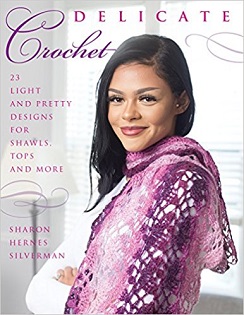
As an educator, Amy Solovay used to teach in-person college courses in trend forecasting, marketing and surface design at California Design College in Los Angeles.
If you’re interested in reading Amy’s personal blog, she invites you to visit her official website, AmySolovay.com.
More Crochet Pattern Books You Might Enjoy
I just added this book to the top of my list of the best crochet flower pattern books. If you want to crochet flower designs, this is currently my top suggestion for a pattern book that will give you useful options. That said, if you want to take a look at some other suggestions for this, you’re invited to check out this list of the best crochet flower pattern books.
I’m also adding the book to my list of recommended crochet books for beginners. This one makes the cut because it includes so many helpful step-by-step photos and work-in-progress pictures. Most of the crochet books in my library do not have this; if you need that feature, this book is a really good one to consider working from.
See Also:
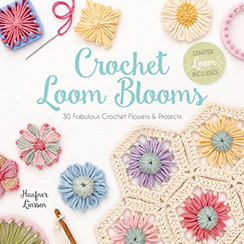
- Crochet Loom Blooms: Patterns, Instructions and Ideas for DIY Flowers + Crochet Motifs
- 31 Patterns for Crocheted Beanies and Slouchy Hats
- My Top Picks for the Best Crochet Books for 2025 and Beyond
Find More Outstanding Craft Books:
- My Top Picks for the Best Christmas Craft Books
- Best Crochet Stitch Dictionaries
- Best Crochet Edging Pattern Books
Over to You:
Have you read Mad Hatter, or made any of the projects from the book? If so, how did you like the book, and how did your projects from it turn out? Let’s talk about it in the comments.
This page was last updated on 10-25-2024.
